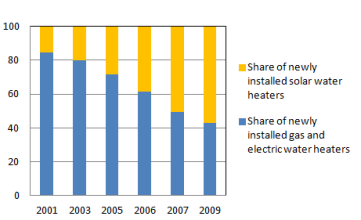China: Industry Increased Export Business 12-fold
February 2, 2012
MarSolar Water Heater Market in China
 Within 6 years, the Chinese solar thermal industry increased its export business 12-fold, from USD 20 million in 2005 to USD 250 million in 2010. In 2011, the newly installed collector area in China has jumped up another 18 % to 57.6 million m2 (40.3 GWth). Putting the focus on solar technology has proven to be the right step: Nowadays, significantly more new solar water heaters are being installed per year than gas or electric water heaters (see chart). These and other market figures were presented by the retired head of the China Solar Thermal Industry Federation (CSTIF), Zhentao Luo, during the IEA SHC roadmap workshop in Beijing in November 2011 (see attached presentation in Chinese).
Within 6 years, the Chinese solar thermal industry increased its export business 12-fold, from USD 20 million in 2005 to USD 250 million in 2010. In 2011, the newly installed collector area in China has jumped up another 18 % to 57.6 million m2 (40.3 GWth). Putting the focus on solar technology has proven to be the right step: Nowadays, significantly more new solar water heaters are being installed per year than gas or electric water heaters (see chart). These and other market figures were presented by the retired head of the China Solar Thermal Industry Federation (CSTIF), Zhentao Luo, during the IEA SHC roadmap workshop in Beijing in November 2011 (see attached presentation in Chinese).
Source: CSTIF/CREIA
According to Luo’s presentation, “China’s Solar Thermal Industry Development Status and Prospects”, the national solar thermal market has grown remarkably in urban areas. The share of city-wide installations has increased from 40 % in 2010 to an estimated 45 % in 2011. The other half of the market is concentrated in the rural regions.
The question of why the urban solar thermal market developed that dynamically was answered by Tao He, Professor at the China Academy of Building Research and Vice Director of the National Centre for Quality Supervision and Testing of Solar Heating Systems (Beijing), during his presentation “Solar Heating and Cooling in China” at an internal IEA SHC meeting in Germany in October 2011 (see attached document). He said: “Over 20 provinces and autonomous regions, as well as over 80 cities have issued compulsory policies favourable to installing solar water heating systems.” The regulations are issued by the local governments – the provincial government itself or a provincial construction commission. Most of these regulations require the installation of a solar water heating system in newly constructed or re-built civil structures of up to 12 storeys – including residential and public ones, as well as hotels and restaurants – to receive construction approval.
Since 2009, there has also been a central government policy which supports certain cities in showcasing renewable energy. Professor He explains that each city could get subsidies of Renminbi Yuan (RMB) 50 million to 80 million (EUR 6 to 10 million, exchange rate EUR = RMB 8.25) to support solar and renewable projects.
The Chinese market is still dominated by residential hot water applications. “There are no more than 10 solar cooling systems currently running in China,” he says in his presentation. Professor He also counted, “around 100 solar space heating systems in operation or under construction”. This sector received support by the government between 2006 and 2008. “359 solar projects received financial support from the central government, 41 % of them were solar heating installations. The grant level was between 50 and 100 RMB per m2 floor space (6 to 12 EUR/m2) when using a solar combi system.
More information:
Solar Heating and Cooling Programme of the International Energy Agency: http://www.iea-shc.org
China Solar Thermal Industry Federation (CSTIF): http://cstif.21tyn.com/
National Centre of Quality Supervision and Testing of Solar Heating System (Beijing): http://www.solar-testing.org/ (under construction)


